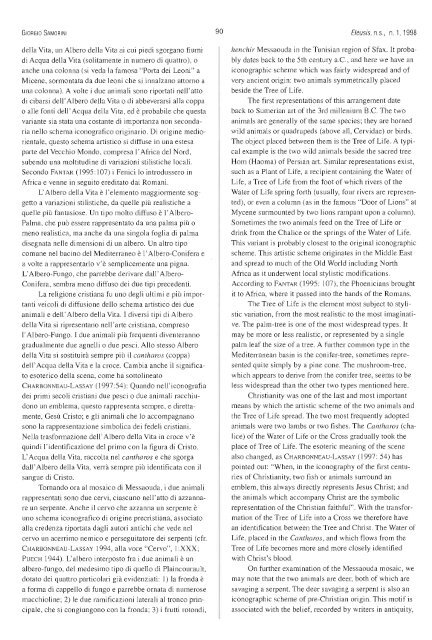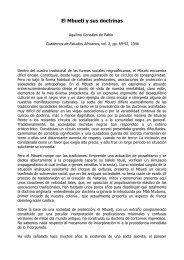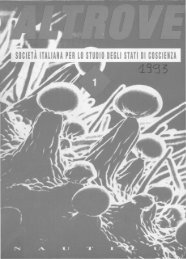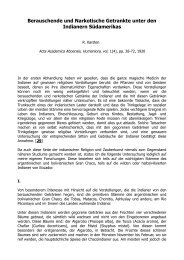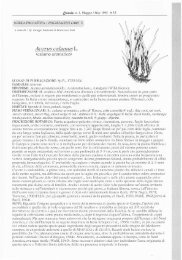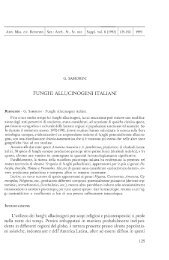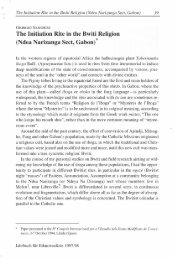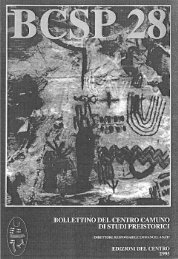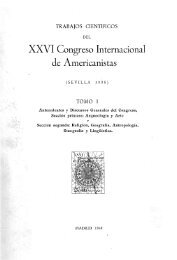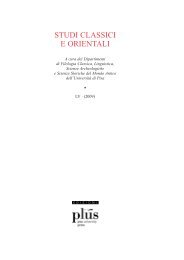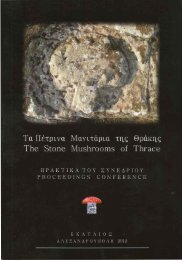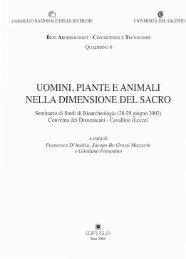Gli "alberi-fungo" nell'arte cristiana - Giorgio Samorini Network
Gli "alberi-fungo" nell'arte cristiana - Giorgio Samorini Network
Gli "alberi-fungo" nell'arte cristiana - Giorgio Samorini Network
Create successful ePaper yourself
Turn your PDF publications into a flip-book with our unique Google optimized e-Paper software.
90<br />
GIORGIO SAMORINI Eleusis, n.s., n. 1, 1998<br />
della Vita, un Albero della Vita ai cui piedi sgorgano fiumi<br />
di Acqua della Vita (solitamente in numero di quattro), O<br />
anche una colonna (si veda la famosa "Porta dei Leoni" a<br />
Micene, sormontata da due leoni che si innalzano attorno a<br />
una colonna). A volte i due animali sono riportati nell'atto<br />
di cibarsi del!' Albero della Vita o di abbeverarsi alla coppa<br />
o alle fonti dell' Acqua della Vita, ed è probabile che questa<br />
variante ia stata una costante di importanza non secondaria<br />
nello schema iconografico originario. Di origine mediorientale,<br />
questo schema artistico si diffuse in una estesa<br />
parte del Vecchio Mondo, compresa l'Africa del Nord,<br />
subendo una moltitudine di variazioni stilistiche locali.<br />
Secondo FANTAR (1995:107) i Fenici lo introdussero in<br />
Africa e venne in seguito ereditato dai Romani.<br />
L'Albero della Vita è l'elemento maggionnente soggetto<br />
a variazioni stilistiche, da quelle più realistiche a<br />
quelle più fantasiose. Un tipo molto diffuso è l'Albero<br />
Palma, che può essere rappresentato da una palma più o<br />
meno realistica, ma anche da una singola foglia di palma<br />
disegnata nelle dimensioni di un albero. Un altro tipo<br />
comune nel bacino del Mediterraneo è l' Albero-Conifera e<br />
a volte a rappresentarlo v'è semplicemente una pigna.<br />
L' Albero-Fungo, che parrebbe derivare dall' Albero<br />
Conifera, sembra meno diffuso dei due tipi precedenti.<br />
La religione <strong>cristiana</strong> fu uno degli ultimi e più importanti<br />
veicoli di diffusione dello schema artistico dei due<br />
animali e dell' Albero della Vita. I diversi tipi di Albero<br />
della Vita si ripresentano nell 'arte <strong>cristiana</strong>, compreso<br />
l'Albero-Fungo. I due animali più frequenti diventeranno<br />
gradualmente due agnelli o due pesci. Allo stesso Albero<br />
della Vita si sostituirà sempre più i/ cantharos (coppa)<br />
dell' Acqua della Vita e la croce. Cambia anche il significato<br />
esoterico della scena, come ha sottolineato<br />
CHARBONNEAU-LASSAY (1997 :54): Quando nell' iconografia<br />
dei primi secoli cristiani due pesci o due animali racchiudono<br />
un emblema, questo rappresenta sempre, e direttamente,<br />
Gesù Cristo; e gli animali che lo accompagnano<br />
sono la rappresentazione simbolica dei fedeli cristiani.<br />
Nella trasformazione dell' Albero della Vita in croce v'è<br />
quindi l'identificazione del primo con la figura di Cristo.<br />
L'Acqua della Vita, raccolta nel cantharos e che sgorga<br />
dall' Albero della Vita, verrà sempre più identificata con i I<br />
sangue di Cristo.<br />
Tornando ora al mosaico di Messaouda, i due animali<br />
rappresentati sono due cervi, ciascuno nell'atto di azzannare<br />
un serpente. Anche il cervo che azzanna un serpente è<br />
uno schema iconografico di origine pre<strong>cristiana</strong>, associato<br />
alla credenza riportata dagli autori antichi che vede nel<br />
cervo un acerrimo nemico e perseguitatore dei serpenti (cfr.<br />
CHARBONNEAU-LASSAY 1994, alla voce "Cervo", l:XXX;<br />
PUECH 1944). L'albero interposto fra i due animali è un<br />
albero-fungo, del medesimo tipo di quello di Plaincourault,<br />
dotato dei quattro particolari già evidenziati: I) la fronda è<br />
a forma di cappello di fungo e parrebbe ornata di numerose<br />
macchioline; 2) le due ramificazioni laterali al tronco principale,<br />
che si congiungono con la fronda; 3) i frutti rotondi,<br />
henchir Messaouda in the Tunisian region of Sfax. lt probably<br />
dates back to the 5th century a.c., and here we have an<br />
iconographic scheme which was fairly widespread and of<br />
very ancient origin: two ani mais symmetrically placed<br />
beside the Tree of Life.<br />
The first representations of this arrangement date<br />
back to Sumerian art of the 3rd millenium B.C. The two<br />
ani mais are generally of the same species; they are horned<br />
wild ani mais or quadrupeds (above all , Cervidae) or birds.<br />
The object placed between them is the Tree of Life. A typical<br />
example is the two wild animals beside the sacred tree<br />
Horn (Haoma) of Persian art. Simi/ar representations exist,<br />
such as a Plant of Life, a recipient containing the Water of<br />
Life, a Tree of Life from the foot of which rivers of the<br />
Water of Life spring forth (usually, four rivers are represented),<br />
or even a column (as in the famous "Door of Lions" at<br />
Mycene surmounted by two lions rampant upon a column).<br />
Sometimes the two ani mais feed on the Tree of Life or<br />
drink from the Chalice or the springs of the Water of Life.<br />
This variant is probably c1oses( to the originai iconographic<br />
scheme. This artistic scheme originates in the Middle East<br />
and spread to much of the Old World including North<br />
Africa as it underwent local stylistic modifications.<br />
According to FANTAR (1995: 107), the Phoenicians brought<br />
it to Africa, where it passed into the hands of the Romans.<br />
The Tree of Life is the element most subject to stylistic<br />
variation, from the most realistic to the most imaginative.<br />
The palm-tree is one of the most widespread types. lt<br />
may be more or less realistic, or represented by a single<br />
palm leaf the size of a tree. A further common type in the<br />
Mediterranean basi n is the conifer-tree, sometimes represented<br />
quite simply by a pine cone. The mushroom-tree,<br />
which appears to derive from the conifer tree, seems to be<br />
less widespread than the other two types mentioned here.<br />
Christianity was one of the last and most important<br />
means by which the artistic scheme of the two animals and<br />
the Tree of Life spread. The two most frequently adopted<br />
animals were two lambs or two fishes. The Cantharos (chalice)<br />
of the Water of Life or the Cross gradually took the<br />
piace of Tree of Life. The esoteric meaning of the scene<br />
also changed, as CHARBOJ\lNEAU-LASSAY (1997: 54) has<br />
pointed out: "When, in the iconography of the first centuries<br />
of Christianity, two fish or animals surround an<br />
emblem, this always directly represents Jesus Christ; and<br />
the ani mais which accompany Christ are the symbolic<br />
representation of the Christian faithful". With the transformation<br />
of the Tree of Life into a Cross we therefore have<br />
an identification between the Tree and Christ. The Water of<br />
Life, placed in the Cantharos, and which flows from the<br />
Tree of Life becomes more and more c10sely identified<br />
with Christ's blood.<br />
On further examination of the Messaouda mosaic, we<br />
may note that the two animals are deer, both of which are<br />
savaging a serpent. The deer savaging a serpent is also an<br />
iconographic scheme of pre-Christian origino This motif is<br />
associated with the betief, record ed by writers in antiquity,


